<<< Part-1 || SEXUAL REPRODUCTION IN PLANTS || Part-3 >>>
Flowering plants (Angiosperms) show sexual reproduction. Flowers are the important reproductive structure produced by Angiosperms to affect sexual reproduction. This post is the Part-2 of Plus Two Botany Notes Sexual Reproduction in Flowering Plants. Here we briefly discuss the Pollination, Pollination Agents, Fertilization and Double Fertilization in Angiosperms. Click here to read the Part – 1 of this notes series.
POLLINATION
Ø Pollination is the transfer of pollen grains from the anther to the stigma of a flower.
Kinds of Pollination:
Ø Depending on the source of pollen grain, the pollination can be:
(1). Autogamy
(2). Geitonogamy
(3). Xenogamy
(1). Autogamy
Ø Autogamy is also known as self-pollination.
Ø The pollen grains are transferred from the anther of a flower to the stigma of the same flower.
Ø It is the pollination within the same flower.
Ø Eg. Rice, Wheat, Pea etc.
Adaptations that Promote Self-Pollination
Ø Stamen and carpel (sex organs) of the flower should mature at the same time (Homogamy).
Ø The anthers and stigma should lie close to each other.
Ø Self-pollinated flowers are usually small, colourless and odourless.
Ø Cleistogamy: A type of self-pollination in some bisexual non-opening flowers. As the flowers do not open at all, there is no chance of cross pollination in cleistogamous flowers.
Chasmogamous Flowers and Cleistogamous Flowers
Ø In some plants such as Viola, Oxalis and Commelina two types of flowers are produced
(a). Chasmogamous Flowers
Ø Chasmogamous flowers are open flowers with exposed anthers and stigma.
(b). Cleistogamous Flowers
Ø Clestogamous flowers are closed flowers.
Ø They do not open at all.
Ø Anthers and stigma lie close to each other.
Ø Pollination takes place inside the flower.
Advantages of Cleistogamy
Ø Cleistogamous flowers are autogamous
Ø There is no chance of cross pollination as the flowers are always closed
Ø Cleistogamous flowers ensure seed set even in the absence of pollinators
(2). Geitonogamy
Ø Geitonogamy is the transfer pollen grains from the anther of a flower to the stigma of another flower of the same plant.
Ø It is the pollination between different flowers of the same plant.
Ø Genetically it is similar to autogamy as the pollen grains are from the same plant.
Ø Functionally it is similar to xenogamy as a pollinating agent is required.
(3). Xenogamy or Allogamy or Cross Pollination
Ø Xenogamy is the transfer of pollen grains from the anther of a flower to the stigma of the flower of another plant of the same species.
Ø It is the pollination between flowers of different plants of the same species.
Ø It brings about genetic recombination and variation.
Merits and Demerits of Cross Pollination (Xenogamy)
Merits of cross pollination
Ø It brings about genetic recombination and variation.
Ø It produces new and improved offspring.
Ø It eliminates harmful or undesirable characters.
Ø Plants with xenogamy show high productivity.
Demerits of cross pollination
Ø The process of pollination depends on the availability of pollinating agents.
Ø The plant needs to develop special features to attract pollinating agents.
Ø Large quantities of pollen grains are to be produced in order to compensate the loss which may occur during pollen transfer.
AGENTS OF POLLINATION
Ø There are two important categories of pollination agents – (1). Abiotic Agents and (2). Biotic Agents
(1). Abiotic Agents
Ø Abiotic agents are non-living agents such as wind and water.
(2). Biotic Agents
Ø Biotic agents are living agents such as insects, birds and bats.
Ø Majority of the plants are being pollinated by biotic agents.
TYPES OF POLLINATION BASED ON THE NATURE OF POLLINATING AGENTS
Ø Abiotic Pollinating Agents (Non-living)
(1). Anemophily: Wind pollination
(2). Hydrophily: Water pollination
Biotic Pollinating Agents (Living)
(a). Zoophily: Animal pollination
(b). Entamophily: Insect pollination
(c). Ornithophily: Bird pollination
(d). Chiropterophily: Bat pollination
(1). ANEMOPHILY (Wind Pollination)
Ø Pollinating agent is wind.
Ø Examples of wind pollinated plants are Coconut, maize, grasses and Cannabis.
Characters of anemophilous / wind pollinated flowers
(1). Flowers
Ø Small flowers with no colour, scent or honey.
Ø Unisexual flowers
Ø Usually arranged in the form of inflorescence (Eg. Corn cob).
Ø They have single ovule in each ovary.
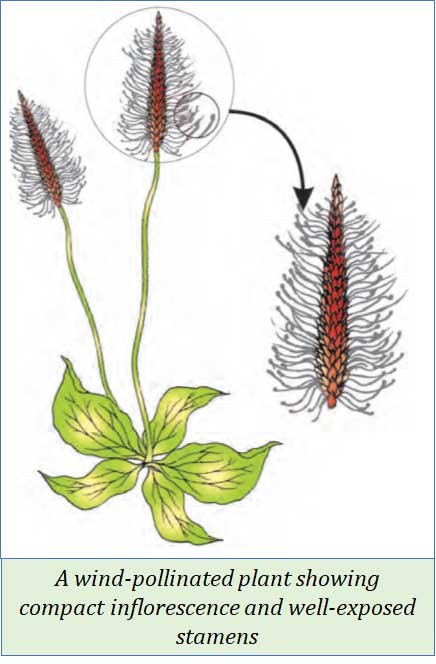
(2). Stamens
Ø Well exposed to disperse the pollen grains into wind currents.
(3). Pollen grains
Ø Light and non-sticky
(4). Stigma
Ø Large and feathery to trap air borne pollen grains easily.
(2). HYDROPHILY (Water Pollination)
Ø Pollinating agent is water.
Ø Examples of water pollinated (Hydrophilous) plants are Zostera, Ceratophyllum, Hydrilla, Vallisneria amd Lemna
Ø Note: All aquatic plants (water hyacinth, water Lily etc.) are not hydrophilous. They are pollinated by wind or insects.
Characters of hydrophilous / water pollinated flowers
(1). Flowers
Ø Small flowers
Ø They are not colourful, showy or attractive.
Ø They do not have scent, honey or nectar
Ø Sepals, petals or perianth segments are protected from wetting due to waxy coating.
(2). Pollen grains
Ø Light and un-wettable due to a mucilaginous covering.
Ø Pollen grains in some plants are long and ribbon like.
(3). Stigma
Ø Sticky but protected from wetting.
Pollination in Vallisneria
Ø Vallisneria is a hydrophilous plant.
Ø The agent of pollination is water.
Ø Vallisneria is a dioecious plant.
Ø Dioecious: Male and female flowers are produced on separate plants.
Ø Male flowers are small, shortly stalked and produced in clusters.
Ø Female flowers are single, produced on long coiled stalk above water.
Ø Pollen grains from male flowers float around female flowers.
Ø Pollination and then fertilization occurs.
Ø The female flower is pulled down as a result of coiling of the long stalk after the fertilization.
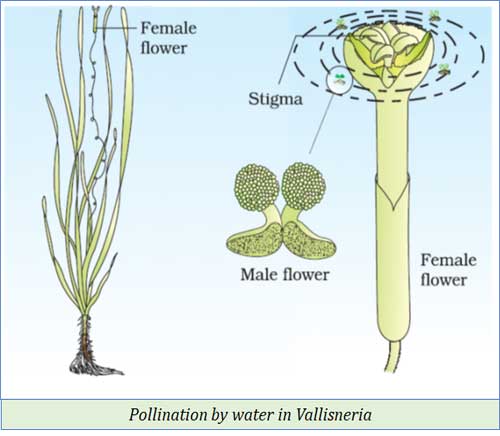
ZOOPHILY (Animal Pollination)
Ø Agents of pollination – Animals
Ø Examples :-
Ø Insects (bees, wasps, beetles, ants, moths, flies)
Ø Birds
Ø Mammals (Bats)
Ø Larger animals (Lemurs, arboreal rodents, reptiles)
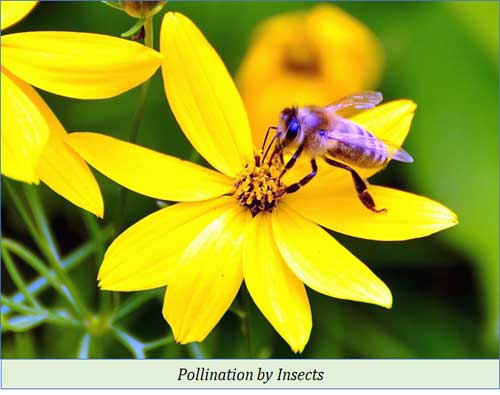
Important Types of Zoophily
(1). Entomophily: Pollination by the agency of insects.
(2). Ornithophily: Pollination by the agency of birds.
(3). Chiropterophily: Pollination by the agency of bats.
ENTOMOPHILY / INSECT POLLINATION
Ø Pollination by the agency of insects.
Ø Examples of Entomophilous flowers / Insect pollinated flowers: Sunflower, Amorphophalus and Caesalpinia.
Ø Insects usually visit the flowers to get food, shelter or a safe place to lay their eggs.
Ø There exists a symbiotic association between the insects and the flowers.
Ø When the insects touch the anthers, pollen grains are coated on their body.
Ø These insects visit another flower and deposit the pollen grains on the stigma of that flower.
Ø Thus, the plants are benefitted with pollination and in turn the insects are rewarded with nectar, honey or pollen grains as food.
Ø In some plants, the flowers also provide a safe place to lay eggs (Yucca, Amorphophalus)
Characters of Entomophilous Flowers / Insect pollinated flowers
(1). Flowers
Ø Large, attractive, brightly coloured and showy flowers
Ø If not large, they are packed as inflorescence to appear as large
Ø They produce fragrance, nectar and honey to attract insects
Ø Fragrance may be pleasant or foul smell
Ø Pleasant smelling flowers attracts bees, butterflies etc. – Jasmine, Rose
Ø Foul smelling flowers attracts carrion flies – Rafflesia, Aristolochia
(2). Pollen grains
Ø Pollen grains will be sticky and spiny
(3). Stigma
Ø Sticky and inserted in the anther cone.
Pollination in Yucca
Ø The pollination method is entomophily.
Ø The pollinating insect is a species of moth.
Ø The plant Yucca and the moth are in symbiotic association with each other.
Ø Both of them require each other to complete their life cycle.
Ø The moth lays egg in the ovary of the Yucca flower.
Ø During this process, pollination occurs
Pollen Robbers
Ø These are insects that consume the nectar or pollen from the flowers without carrying out pollination.
Outbreeding Devices / Adaptations to Promote Xenogamy or Cross Pollination
Ø Continued self-pollination may lead to inbreeding depression in plants.
Ø It may cause reduced biological fitness.
Ø Some plants with bisexual flowers have developed devices or adaptations to prevent self-pollination since their pollen grains may come in contact with their stigma.
Ø These out breeding devices or adaptations are:
(1). Dichogamy
Ø Pollen release and stigma receptivity are not in time.
Ø That means pollens and stigma do not mature at the same time.
(2). Position of anther and stigma
Ø Anther and stigma are placed at different positions within the flower.
Ø So that they cannot come in contact with each other.
(3). Self-incompatibility
Ø The genetic mechanism in which the self-pollen is being rejected from fertilizing the ovules
Ø It is achieved by:
-
- Inhibiting the germination of self-pollen.
Or
-
- Inhibiting the growth of the pollen tube in the pistil.
(4). Production of unisexual flowers
Ø Monoecious plants: Male and female flowers are on the same plant
Ø Eg. Maize, Castor
Ø These plants prevent autogamy, but not Geitonogamy
Ø Dioecious plants: Male and female flowers are on different plants
Ø Eg. Papaya, Date palm
Ø These plants prevent both autogamy and geitonogamy.
Pollen Pistil Interaction
Ø Pollen pistil interaction starts from pollination where the pollen grains get deposited on the stigma.
Ø The pollen grains germinate on the stigma and produce pollen tube.
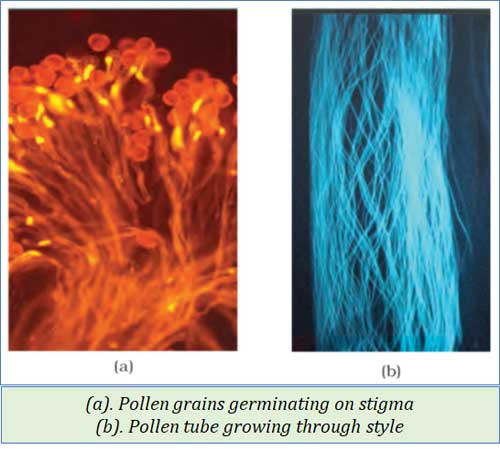 Ø The pollen tube grows through stigma and style to reach the ovary.
Ø The pollen tube grows through stigma and style to reach the ovary.
Ø Within the ovary the pollen tube enters into the ovule through micropyle, chalaza or integuments.
Ø Filiform apparatus guides the pollen tube into the embryo sac.
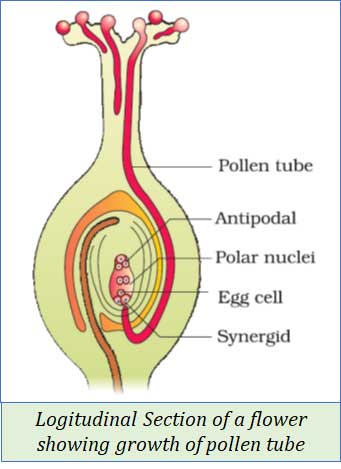 Ø Some pollen grains are shed at two celled stage and some at three celled stages.
Ø Some pollen grains are shed at two celled stage and some at three celled stages.
Ø Pollen tube carries two male gametes.
Ø All these processes together are known as pollen pistil interaction.
$. Pollination does not ensure fertilization.
$. The pollen grains deposited on the stigma could be compatible or incompatible.
$. The stigma has the ability to recognize compatible pollen grains.
$. Only the compatible pollen grains are allowed to germinate on the stigma.
ARTIFICIAL HYBRIDIZATION
Ø Artificial hybridization is the process of crossing two genetically different organisms artificially.
Ø Artificial hybridization can be completed in four steps:
(1). Emasculation
(2). Bagging
(3). Artificial pollination
(4). Re-bagging
(1). Emasculation
Ø Emasculation is the removal of anthers from flower buds of the female parent.
Ø It is done using a pair of forceps before the anther dehisces.
Ø It is not done in unisexual flowers.
Ø Aim of emasculation: To prevent self-pollination.
(2). Bagging
Ø Covering the emasculated flowers with butter paper bag.
Ø Aim: To protect the flower from unwanted pollen grains.
(3). Artificial pollination
Ø When the stigma of the flowers matures, the bag is removed temporarily.
Ø The pollen grains collected from the selected male flower are dusted on the stigma.
(4). Re-Bagging
Ø The pollinated flowers are re-bagged.
Ø Aim: To protect the flower from un wanted pollen grains.
DOUBLE FERTILIZATION
Ø Fertilization in angiosperm flower is called double fertilization because it involves two fusions.
Ø These two fusions in double fertilization are:
(1). Syngamy
(2). Triple fusion
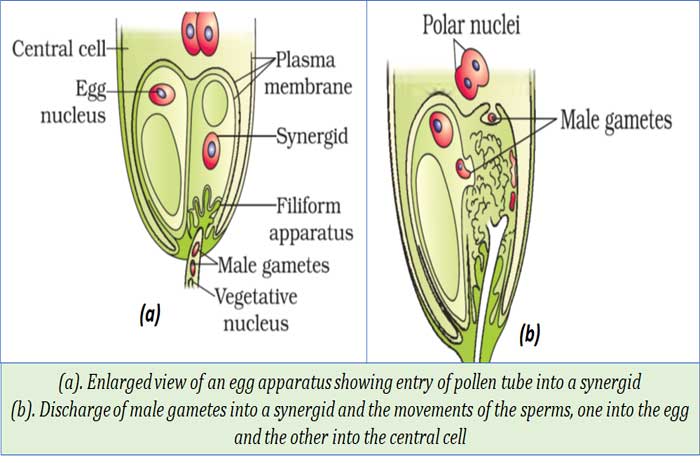
(1). Syngamy
Ø Syngamy is the fusion of one male gamete (n) with the egg (female gamete) (n).
Ø It produces diploid Zygote (2n).
(2). Triple Fusion:
Ø The fusion of another male gamete (n) with two Polar nuclei (n+n).
Ø It produces triploid Primary Endosperm Nucleus (PEN) (3n).
Post fertilization Events (events after fertilization)
(1). Zygote develops into Embryo|
(2). Ovary develops into Fruit
(3). Ovule develops into Seed
(4). Primary Endosperm Nucleus develops into Endosperm
Identify the Ploidy of plant parts:
| PLANT PART | PLOIDY | |
| 1 | Egg | Haploid (n) |
| 2 | Pollen grain | Haploid (n) |
| 3 | Male / Female gamete | Haploid (n) |
| 4 | Zygote | Diploid (2n) |
| 5 | Embryo | Diploid (2n) |
| 6 | Endosperm | Triploid (3n) |
| 7 | PEN | Triploid (3n) |
GIVE ONE WORD:
- Formation of microspores – Microsporogenesis
- Formation of megaspores – Megasporogenesis
- Gynoecium with one carpel – Monocarpellry
- Gynoecium with many carpels – Multicarpellary
- Gynoecium with free carpels – Apocarpous
- Gynoecium with fused carpels – Syncarpous
- Male Gametophyte – Pollen Grain
- Female Gametophyte – Embryo sac
So far, we have discussed the Pollination, Fertilization and Double Fertilization. In the next post we will see the Post-pollination process in the Sexual Reproduction of Flowering Plants, i.e., development of embryo and structure of seed. You can Download the PDF of this note from here. Hope this post was helpful for your learning. We would like to hear it from you. Please COMMENT (below ↓)
<<< Back to PLUS TWO BOTANY NOTES Page
You might also like…
@. Plus Two Biology Previous Year Question Papers
@. Plus One Biology Previous Year Question Papers
@. Model Question Papers
